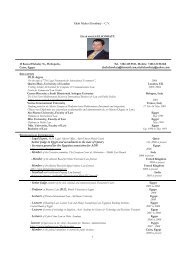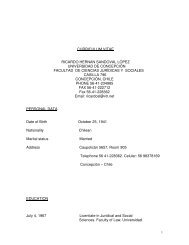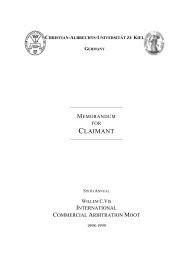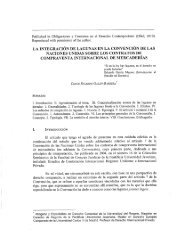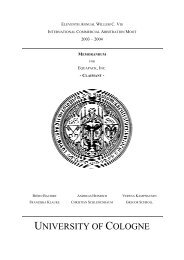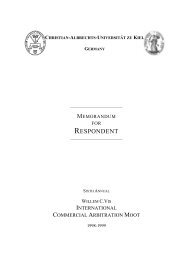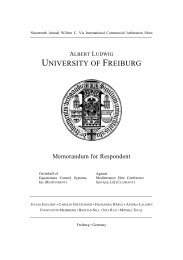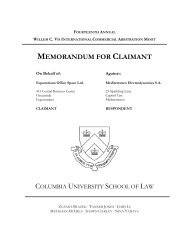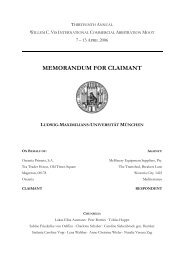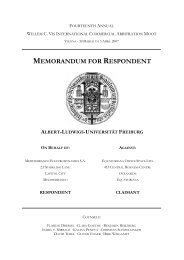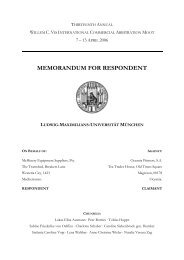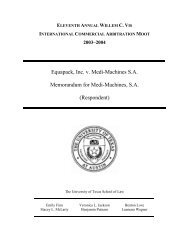MEMORANDUM FOR RESPONDENT - Pace University
MEMORANDUM FOR RESPONDENT - Pace University
MEMORANDUM FOR RESPONDENT - Pace University
Create successful ePaper yourself
Turn your PDF publications into a flip-book with our unique Google optimized e-Paper software.
QUEEN’S UNIVERSITY FACULTY OF LAW<br />
ARGUMENT<br />
PART ONE: THE TRIBUNAL LACKS JURISDICTION TO HEAR THE PARTIES’<br />
DISPUTE.<br />
1. The Tribunal does not have jurisdiction to hear the Parties’ dispute because the Tribunal was not<br />
constituted according to the Parties’ agreement. As a preliminary matter, Respondent does not<br />
contest that the Parties executed a valid arbitration agreement. Both Parties agree that the<br />
Dispute Settlement clause in the Sale Confirmation constituted an arbitration agreement<br />
(“Agreement”), and provided that Danubia would be the seat of the arbitration [Cl. Ex. 4; Resp.<br />
Ex. 2]. Accordingly, the Parties are bound by Danubia’s national arbitration law, the<br />
UNCITRAL Model Law on International Commercial Arbitration, 2006 Amendments (“Model<br />
Law”) [Req. for Arb. 25; Blackaby et al. 164]. Art. 16 Model Law, which codifies the widely-<br />
accepted principle of competence-competence [Blackaby et al. 346; Born 868; Bühring-Uhle et al.<br />
2006 47; Lew et al. 332], confers on the Tribunal the power to rule on its own jurisdiction. The<br />
Tribunal should invoke its competence to conclude that it was not constituted according to the<br />
Parties’ Agreement [I]. Respondent did not waive its right to raise an objection [II]; and, if the<br />
Tribunal affirms its jurisdiction, an eventual award is at risk of being set aside or refused<br />
recognition and enforcement [III].<br />
I. THE TRIBUNAL WAS NOT CONSTITUTED ACCORDING TO THE PARTIES’ AGREEMENT.<br />
2. By referring to the “Rules of the Chamber of Arbitration of Milan” in the Agreement, the Parties<br />
expressly agreed to be bound by the Milan Rules [Cl. Ex. 4; Resp. Ex. 2; art. 1 2010 Milan Rules;<br />
Nacimiento in Kronke et al. 282]. Both art. 14(1) of those Rules and art. 11(2) Model Law allow<br />
parties to agree on a procedure for constituting a tribunal. The Parties exercised this power to<br />
require that each appoint one arbitrator, and that the two party-appointed arbitrators jointly<br />
appoint the presiding arbitrator [Cl. Ex. 4; Resp. Ex. 2].<br />
3. An arbitral tribunal lacks jurisdiction when it has not been constituted according to the parties’<br />
agreement [art. V(1)(d) NY Convention; Nacimiento in Kronke et al. 281]. Here, contrary to the<br />
Parties’ Agreement, the presiding arbitrator of the Tribunal was chosen by the Arbitral Council<br />
(“Council”)—not by the two party-appointed arbitrators. As a result, the Tribunal lacks<br />
jurisdiction [art. 34(2)(a)(iv) Model Law; art. V(1)(d) NY Convention]. The Council did not comply<br />
with the Parties’ Agreement in denying confirmation of Mr. Y [A], nor in appointing Mr. Z as<br />
the presiding arbitrator [B].<br />
2



